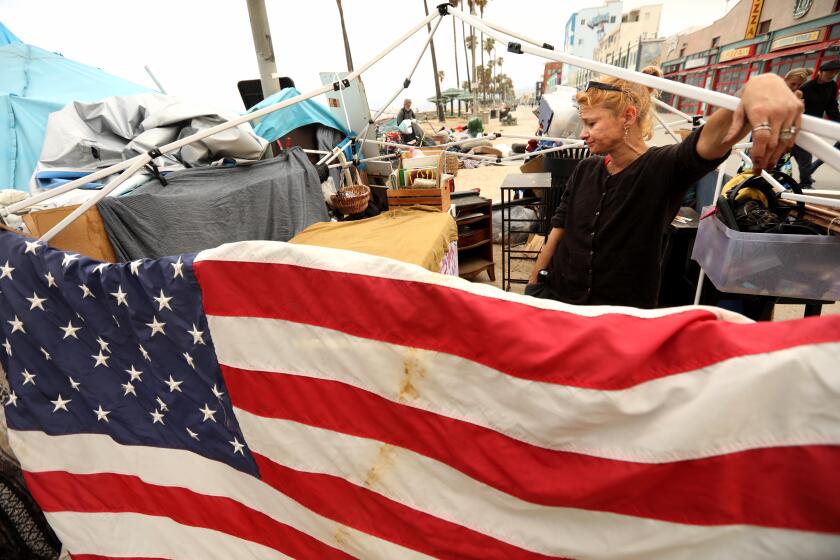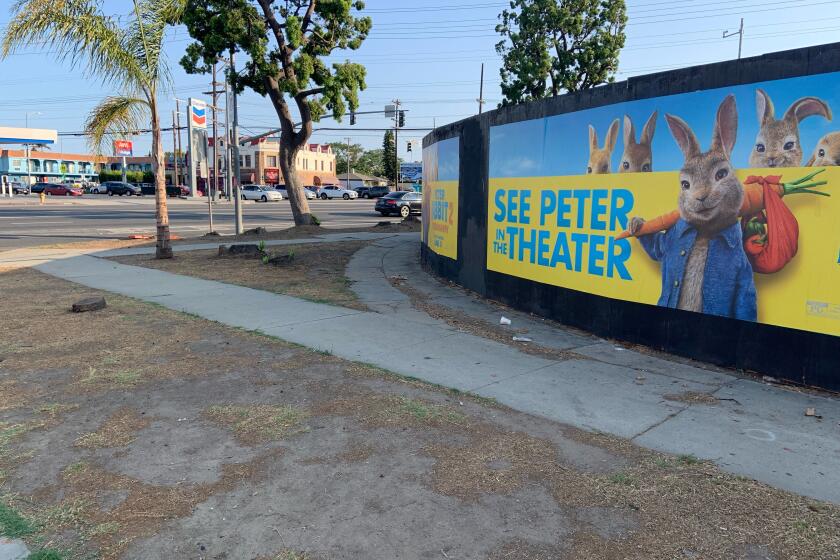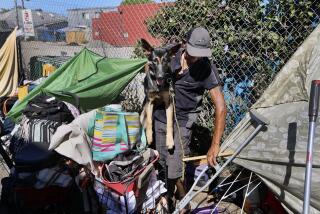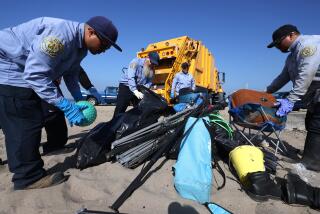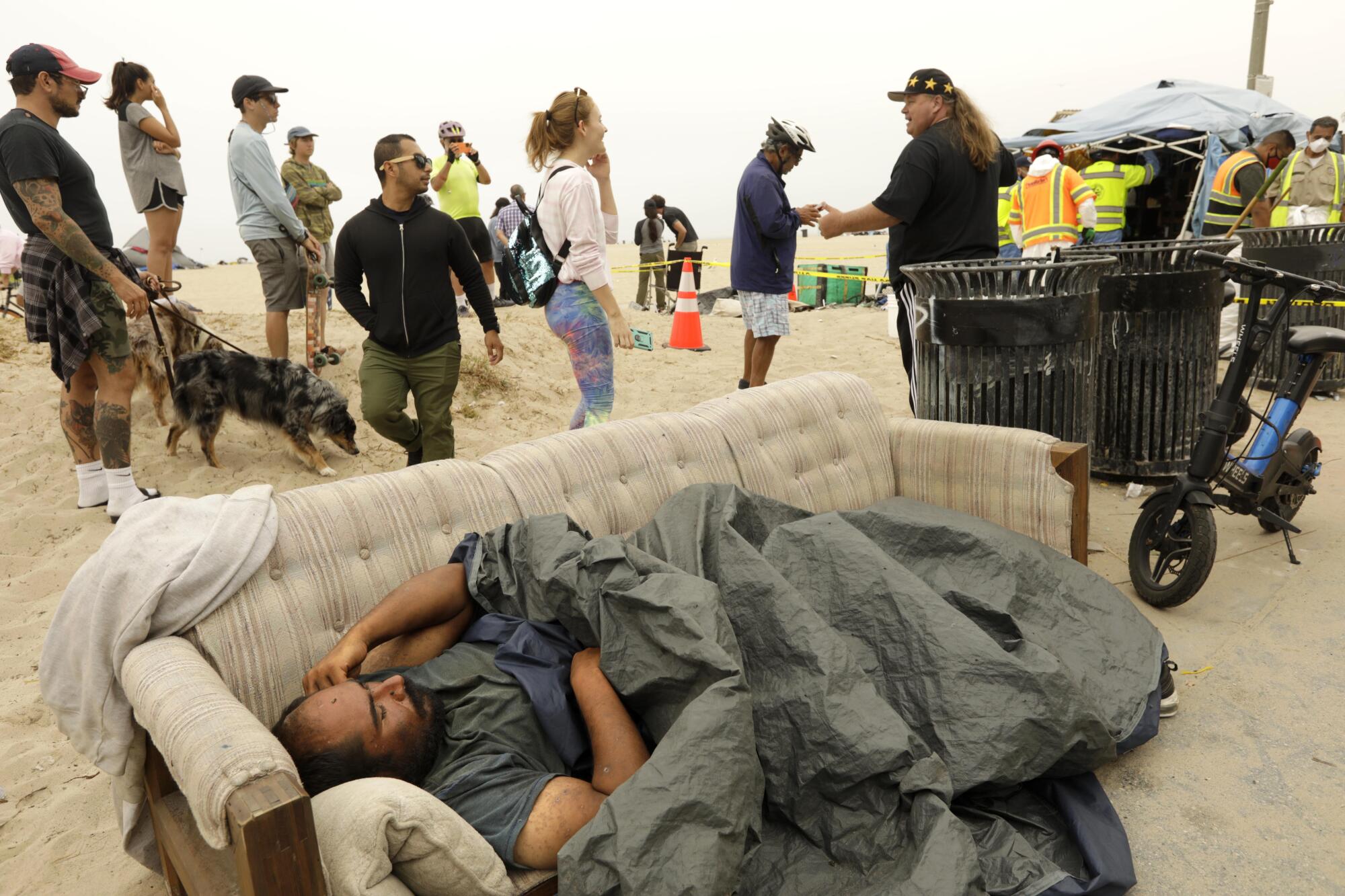
Seated under an umbrella, Teresa Robles and her friend Dixie Moore laughed at stories of each other’s adventures, Robles telling of the time she first came to Venice and fell in love.
Not with a man, but with this stretch of seaside — where she slept for much of last year and would return if that were allowed.
Robles loved letting her dog, Notcho, roam as she made art in her tent and woke up with waves crashing against the shore. That dream ran up against a different reality last month when the city began to enforce rules against pitching tents on the grassy strip along Ocean Front Walk — in hopes of letting vendors return and reducing the chaos that had defined the oceanfront strip in recent months.
Both Robles and Moore had slept near where they were sitting and chatting. Not anymore.
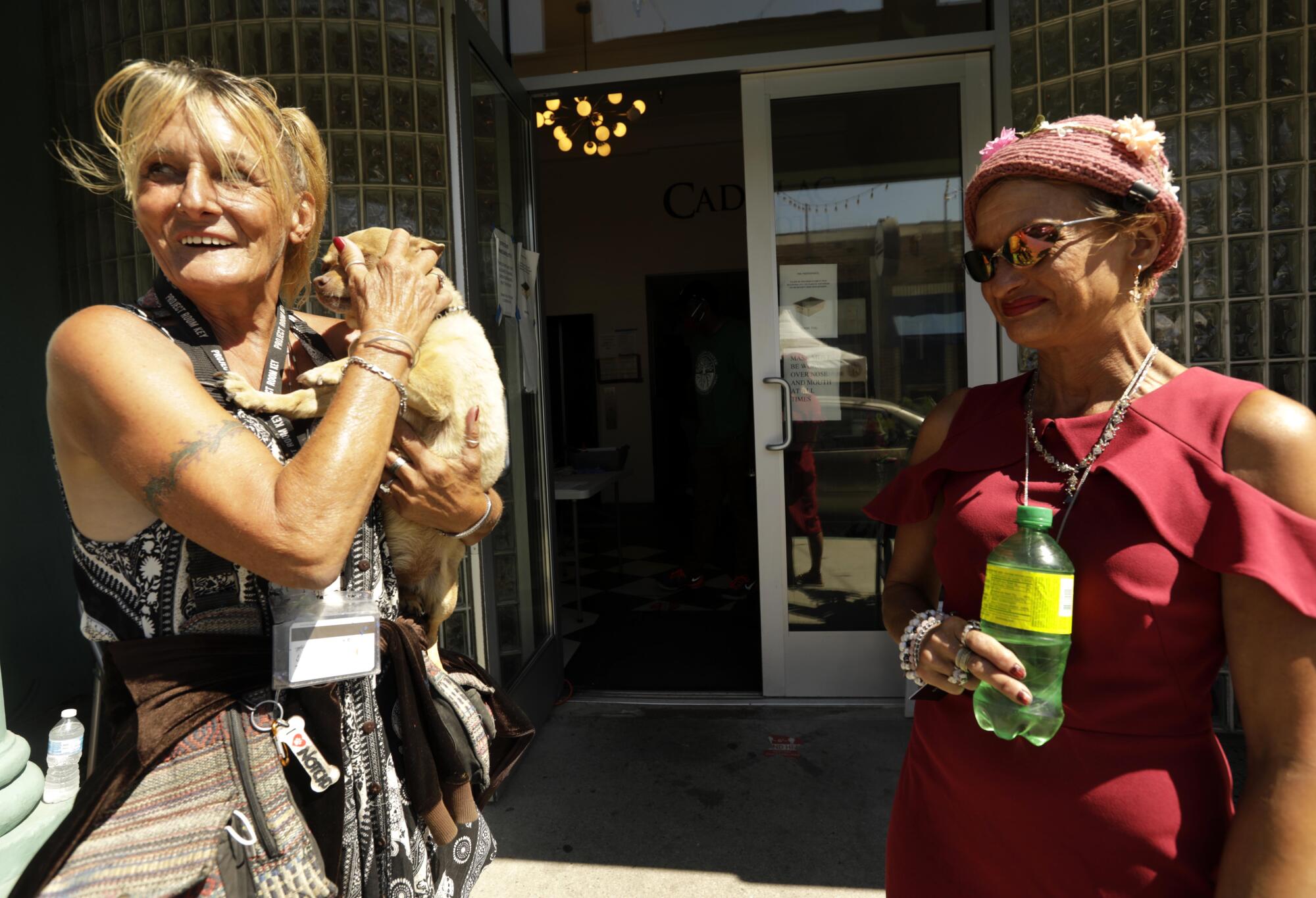
After a month of intensive outreach, persuasion by police and park rangers, and painstaking separation of valuables from the jerry-built structures and furnishings, Robles and Moore were two of the roughly 200 campers who were removed from the famed half-mile stretch. All were offered someplace else to live — a few in apartments, many in private but temporary rooms in hotels, and a few in congregate shelters. Most took up the offer.
The beach and the boardwalk, with its clothing stores, henna tattoo stalls and restaurants, among other attractions, had few tents left Friday after an intense six-week infusion of resources to help the unhoused sleeping there find new places to stay.
A plan for how to solve Venice’s homeless crisis has emerged from behind-the-scenes talks among a coalition of Venice activists, city officials and deputies of the area’s city councilman.
The effort sought to balance the welfare of people living on the streets with the desires of business owners and residents who wanted there to be no tents on the boardwalk.
Robles had been living with her son in San Bernardino until the Hillside fire in 2019 destroyed her home. The 63-year-old bounced around among family members, then moved to the beach to make art and return to a place that had long attracted her.
Robles and Moore landed at the Cadillac Hotel, just off the boardwalk — and despite her desire to return to the beach, Robles said she enjoys the queen-size bed, free TV and three meals a day. She was frustrated that security guards confiscated several of the scissors she uses for her art and that they don’t let her bring in the vodka she likes to drink. A nonprofit veterinarian came to the hotel and pulled some of Notcho’s teeth that had become infected. Robles now wears one of his fangs like a pendant around her neck.
“The hotel is nice,” Robles said. “I went to the shelter for a week when I first arrived, but Notcho and I didn’t like it. It wasn’t really private enough.”
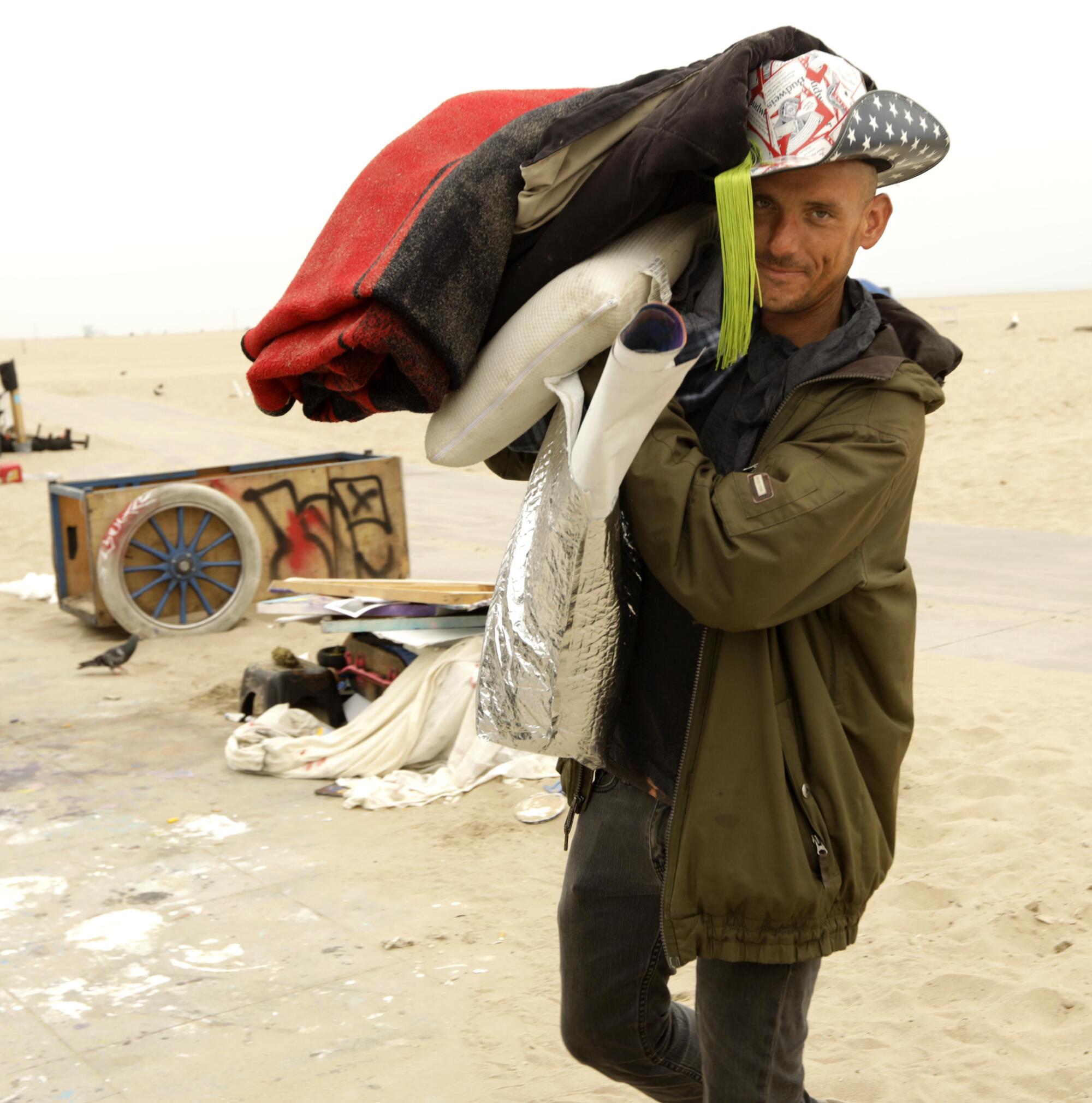
Moore sat at her side on the sand, inspecting the beach scenes Robles painted on shells. Unlike Robles, who missed sleeping outdoors, Moore was eager for an apartment and some privacy. The hotel offered her that after she spent the better part of the last year surrounded not only by friends on the boardwalk but also by violence and chaos.
That’s a life she wants to leave behind. The hotel has a curfew of 10 p.m., which makes her feel as if it’s a prison, but she sees the bigger picture. In the next few weeks, once her housing subsidy comes through, she’ll start apartment hunting.
When she finds a place, she looks forward to entertaining her children and grandchildren.
“I want permanent housing for myself,” said Moore, 47. “She needs something permanent too.”
Behind them, Los Angeles Police Department officers and outreach workers trawled the sand looking for the people who had chosen instead to take what they could gather a few yards away and pitch their tents on the beach.
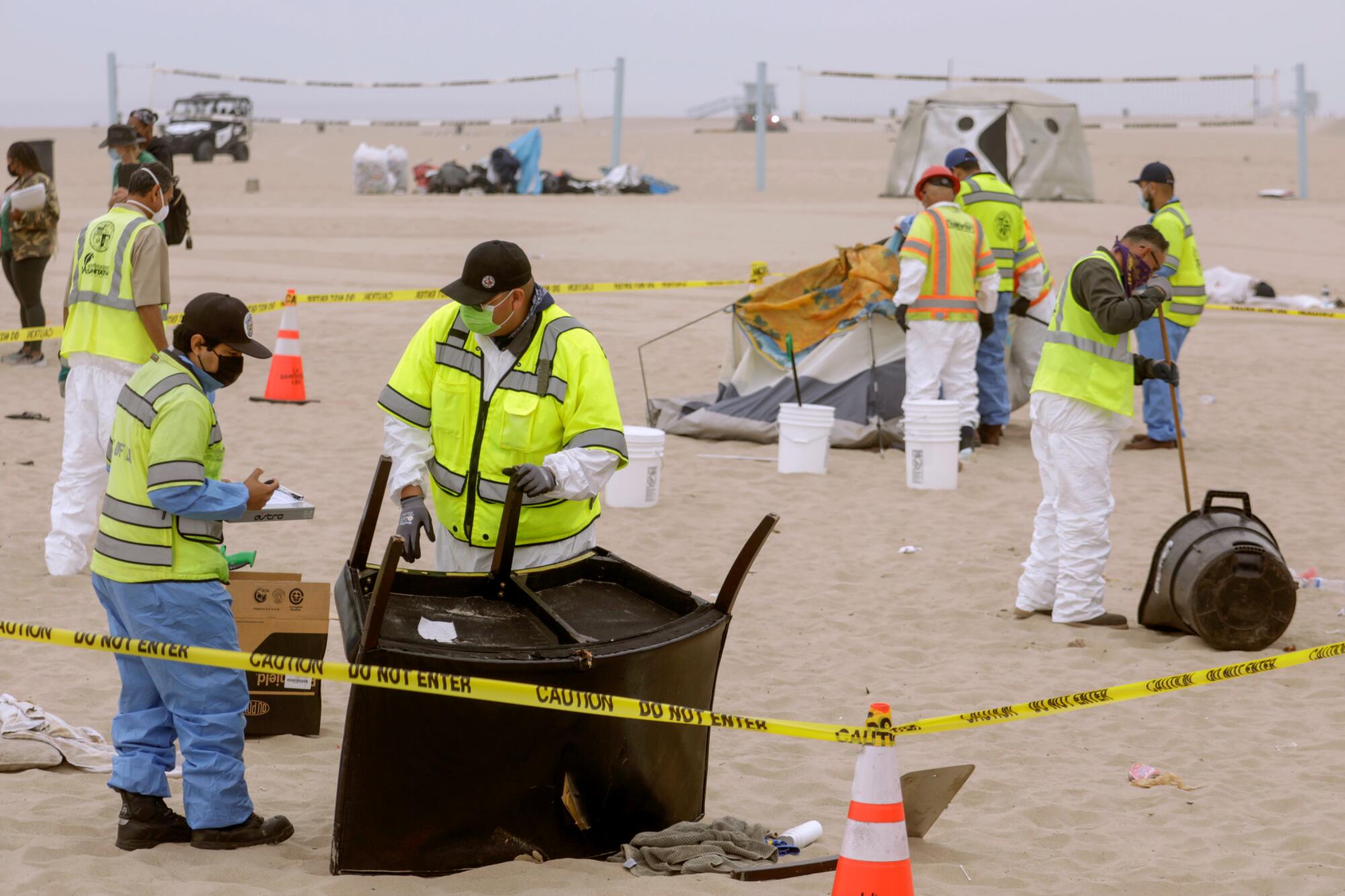
By midweek, even as merchants and community activists were welcoming the dramatic change on the narrow strip of earth bordering the concrete walkway, about 50 tents were pitched where none had previously been on the wide stretch of sand between the boardwalk and the sea.
Their appearance was a worrisome development for the program launched by City Councilman Mike Bonin to relocate more than 200 homeless people with a minimum of law enforcement and a maximum of aid.
Community groups that pressed Bonin for the cleanup were reserving judgment on its success until they see how the city deals with the tents in the sand, and how well it does at keeping new camps from being established.
“It’s nice to see all this progress happening,” said Brian Averill of the group Venice Boardwalk Action Committee, which first outlined the boardwalk cleanup plan in a January proposal. “I want to see them end strong. They need to come with some sort of concrete plan to continue prohibiting camping on the beach.”
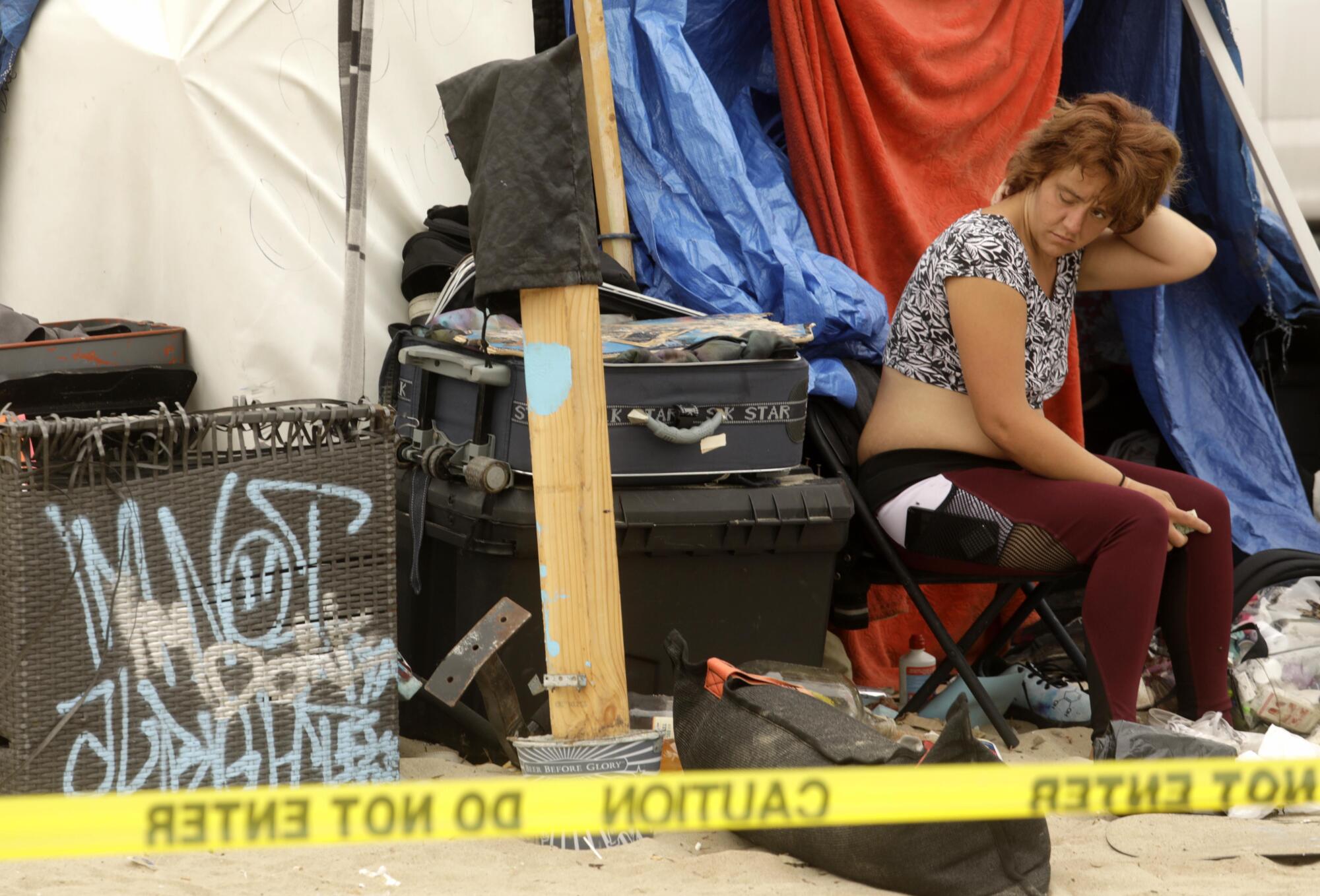
By Friday morning, close to a dozen sanitation workers with the city of Los Angeles and contract workers with the county Department of Beaches and Harbors cleared encampments and debris a few yards at a time on the beach near Thornton Avenue and Ocean Front Walk.
A lone LAPD officer showed up at the start around 8 a.m., took a few photos and eventually left.
Three men recount their family ties, their romances, how they came to live on the street and how they make ends meet.
Michael Freeman, 19, hummed quietly as he packed up his tent and belongings. Originally from New Orleans, he’d been living homeless in California for six years and for the last few months had been bedding down in Venice.
“Everything I have fits in this bag,” Freeman said, referring to a knapsack in which he planned to carry away his tent and his clothing. I “hope to get a job. Have a family. Make a living.”
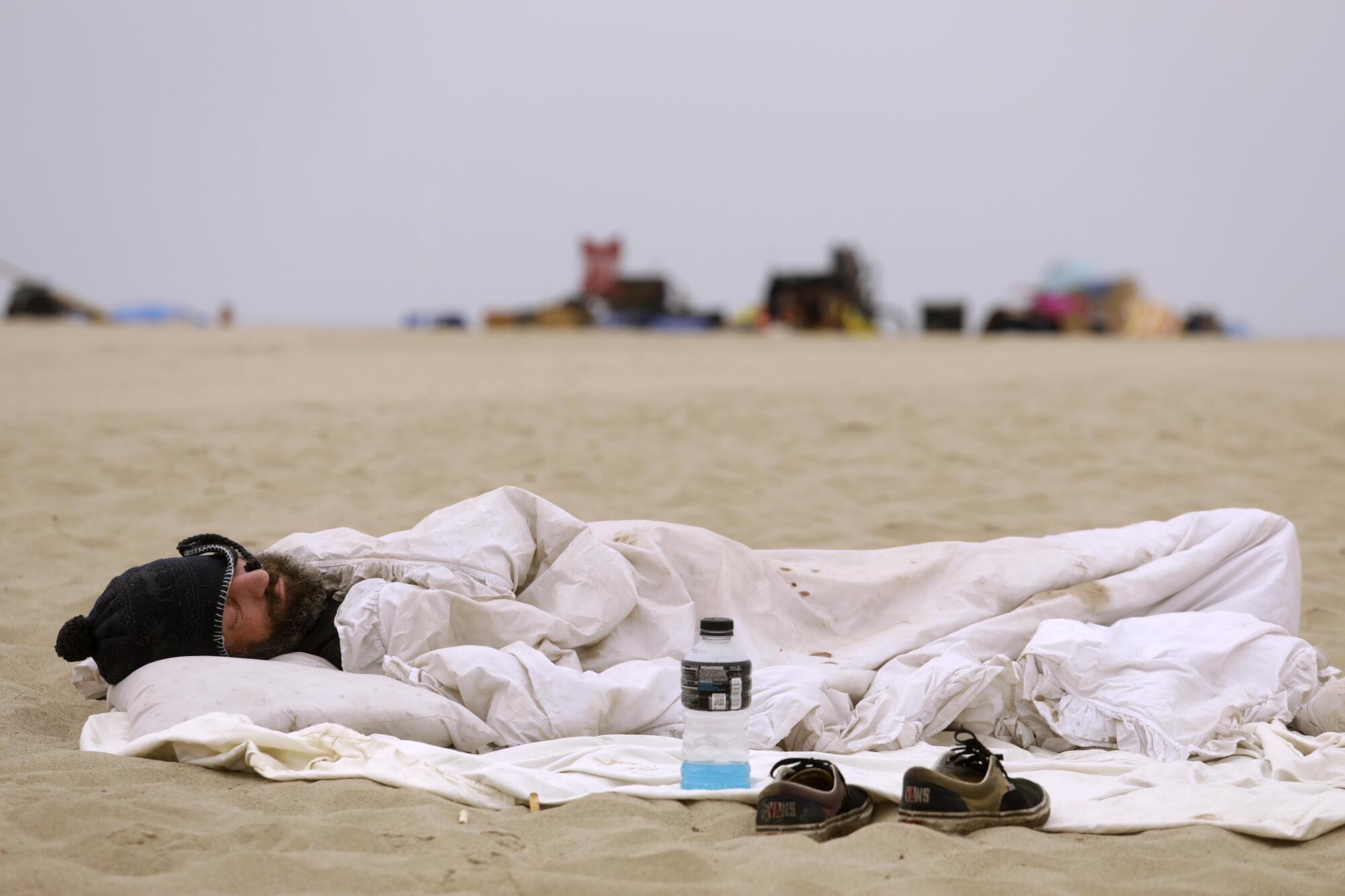
“Venice Beach had been one of the craziest times I’ve lived,” he said as he left the beach, a skateboard over his shoulder. He was heading to a hotel room in Inglewood that had been arranged for him and two friends by St. Joseph Center, the nonprofit organizing the outreach on the beach, and the Los Angeles Homeless Services Authority.
He was relieved to finally be getting off the street — even if it was temporary.
Nearby, Kenny Carpenter, 34, folded blankets and collected his pots and pans before cleanup crews arrived. He made several trips to garbage cans on the boardwalk.
Originally from the San Fernando Valley, he has been homeless for three years and on the beach in Venice for the last couple of weeks. He was sporting a black eye that he received in a recent fight. He became homeless because of depression after his wife and son left him.
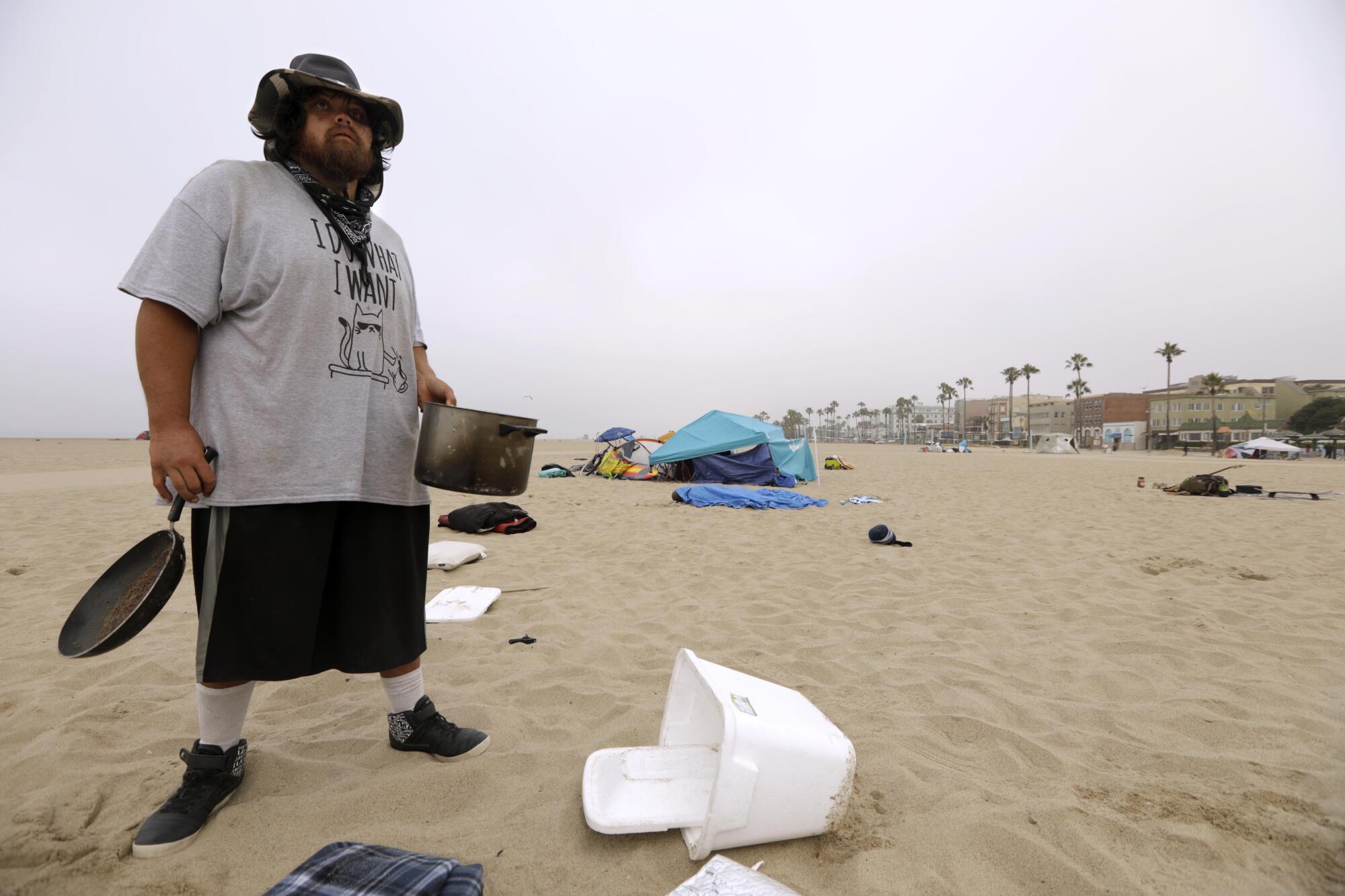
“I’m still hopeful. Broke but not hopeless,” he said. He left the beach with Mark Douglas, 58, who offered him housing at his home in Bishop. Carpenter placed his belongings in Douglas’ truck.
“God provides,” Carpenter said.
For Matias Moreno, 31, the clearing of tents on the boardwalk has been a welcome change for his restaurant, the Fig Tree. He spent summers working at the Venice mainstay since his family bought the place in 2005. Last year, he took over management alongside a high school friend, chef Dashiell Nathanson, who reimagined the menu.
Moreno said he was constantly contending with fights outside the restaurant and employees and patrons who felt unsafe. At least one staff member had been harassed on the boardwalk, and he worried that the situation would drive away customers.
He sent emails to elected officials explaining the situation and pleading for change. Now that it’s finally come, he’s glad that politicians found a way to do right by the people who had been camping alongside the boardwalk by finding them a place to stay, while also clearing the area of tents.
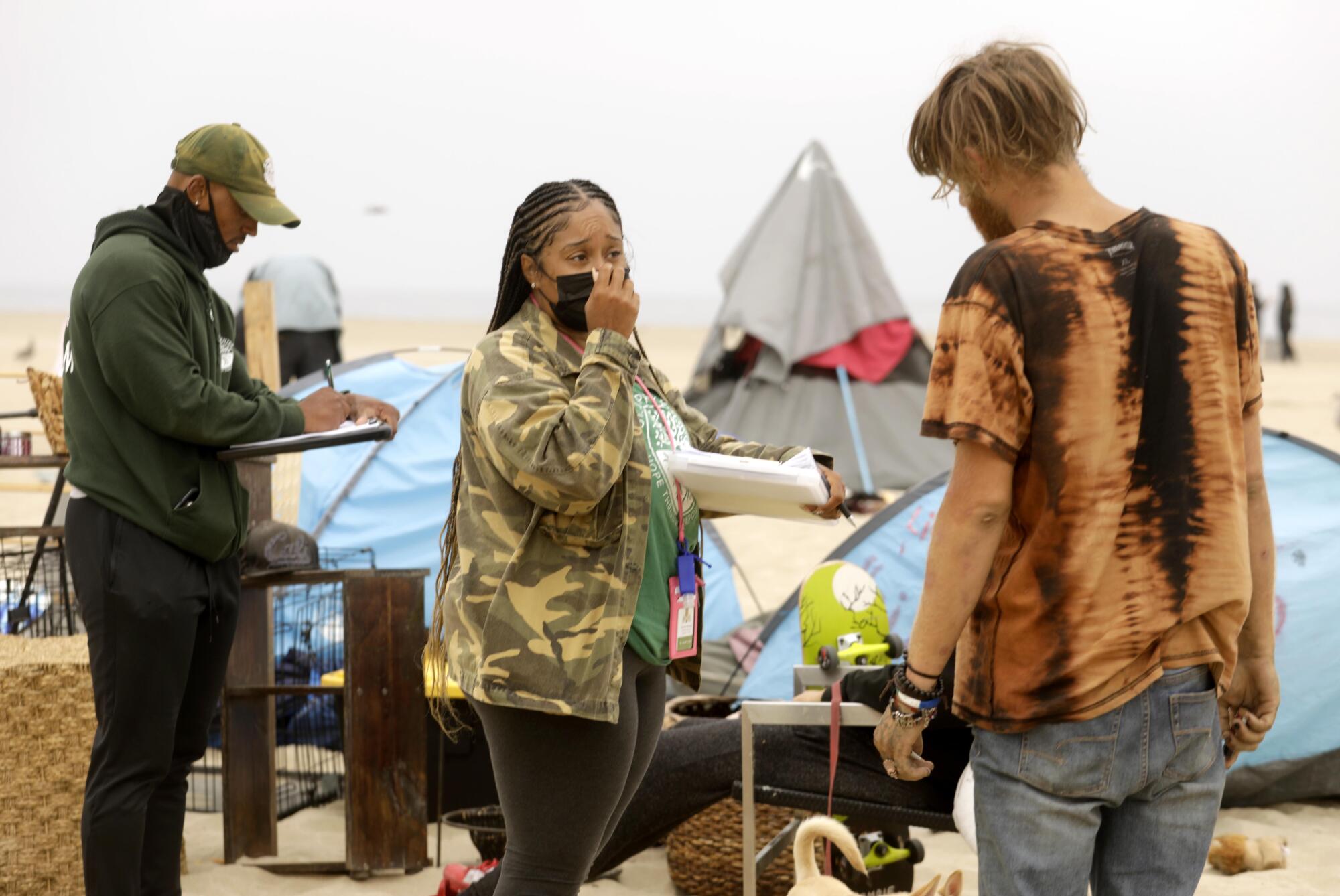
Still, he remains worried that once tourism season is over and attention fades, the tents could return.
“I hope their vision extends further than the next six months,” Moreno said.
Bonin, who was the public face of the effort to get people out of tents and into some form of housing, said in an interview Friday that he had every expectation that rules prohibiting camping in parks and on beaches would be enforced. Bonin pushed for this encampment-to-home model, in which outreach workers would come in and make offers of shelter or housing before the municipal code was enforced again.
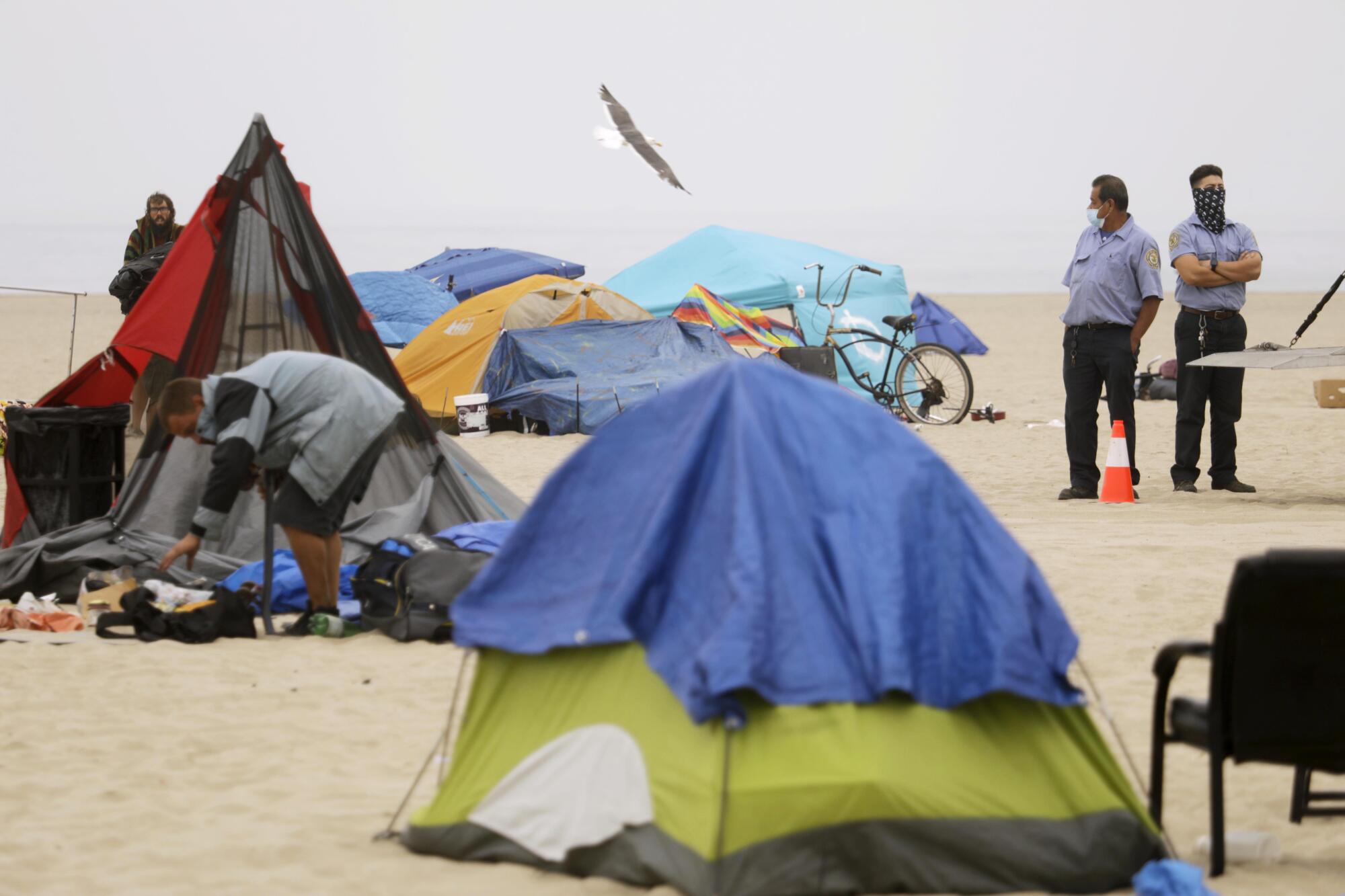
For Bonin, the people who went indoors over the last six weeks disproved the trope that homeless people just want to stay homeless. While pleased with the effort, he said it can truly be judged as a success only if and when people are permanently housed.
“A lot of people are judging this program by how the boardwalk looks. That’s a metric that’s visible,” Bonin said. “But the metric that matters is how many people are housed. Helping people move off the streets permanently is the primary goal and the measure of success.”
Acknowledging that almost all the 211 people moved from the boardwalk by St. Joseph Center had ended up in interim housing, Bonin declined to declare the program a success yet.
“For my goal, they can’t say success or mission accomplished until people are into the long-term or the permanent placements,” Bonin said.
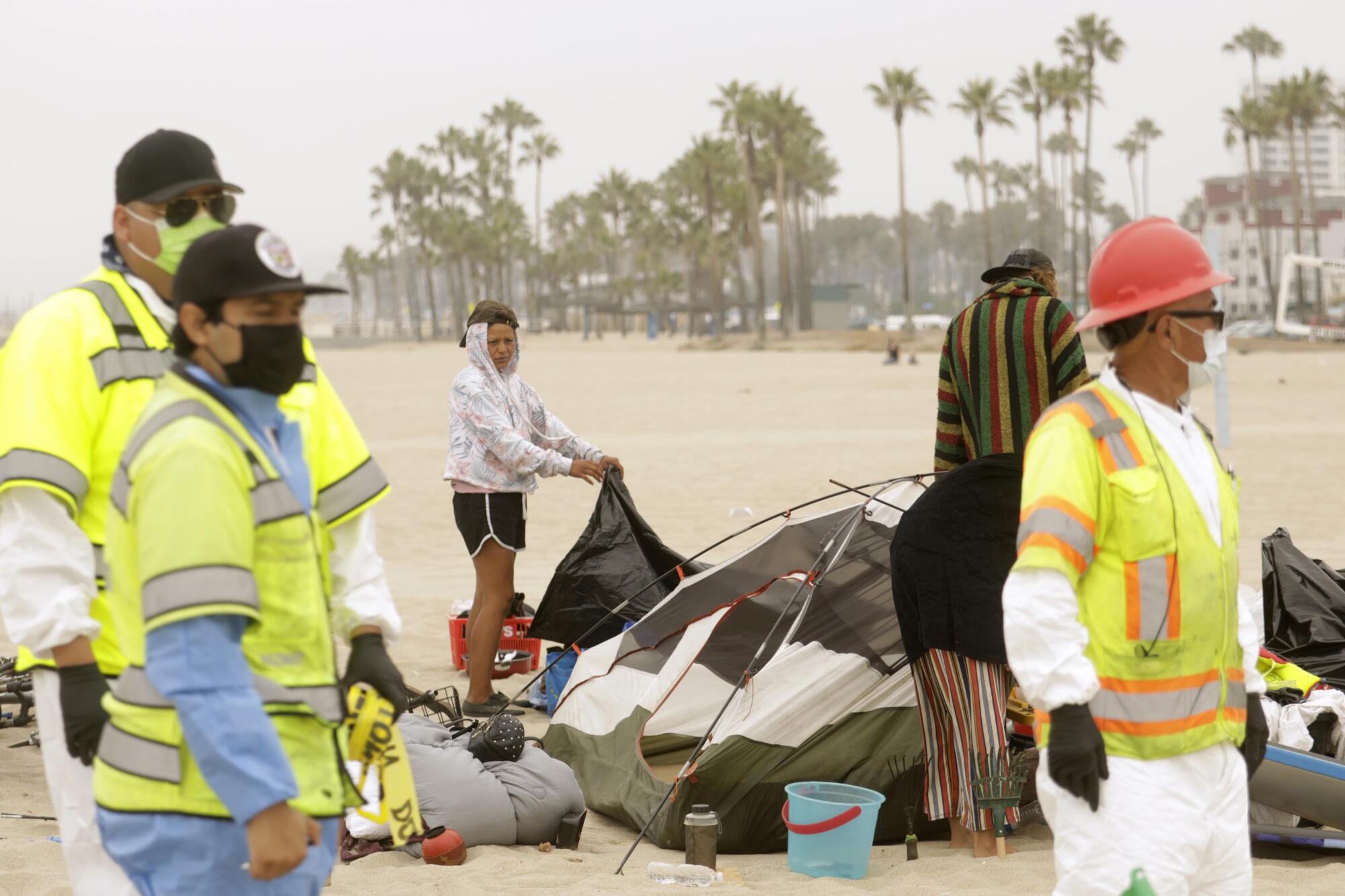
Va Lecia Adams Kellum, president and chief executive of St. Joseph Center, said that would probably take six months. She said that 116 of the 211 people have been matched to housing subsidies but still have to find apartments.
Back on the boardwalk Thursday, the day before the cleanup concluded, Moore inspected the shells Robles collected and transformed into vibrant seascapes. Living in tents for months next to each other, sharing meals and guarding the other’s possessions had cemented a bond between the two.
They encouraged each other’s interest in art as well.
Moore helped pack up Robles’ art, which she doesn’t sell but gives away to tourists. If they give her a dollar or two, all the better. The two strolled along the boardwalk back to the Cadillac Hotel — stopping to say hello to friends — as 13-year-old Notcho waddled behind.
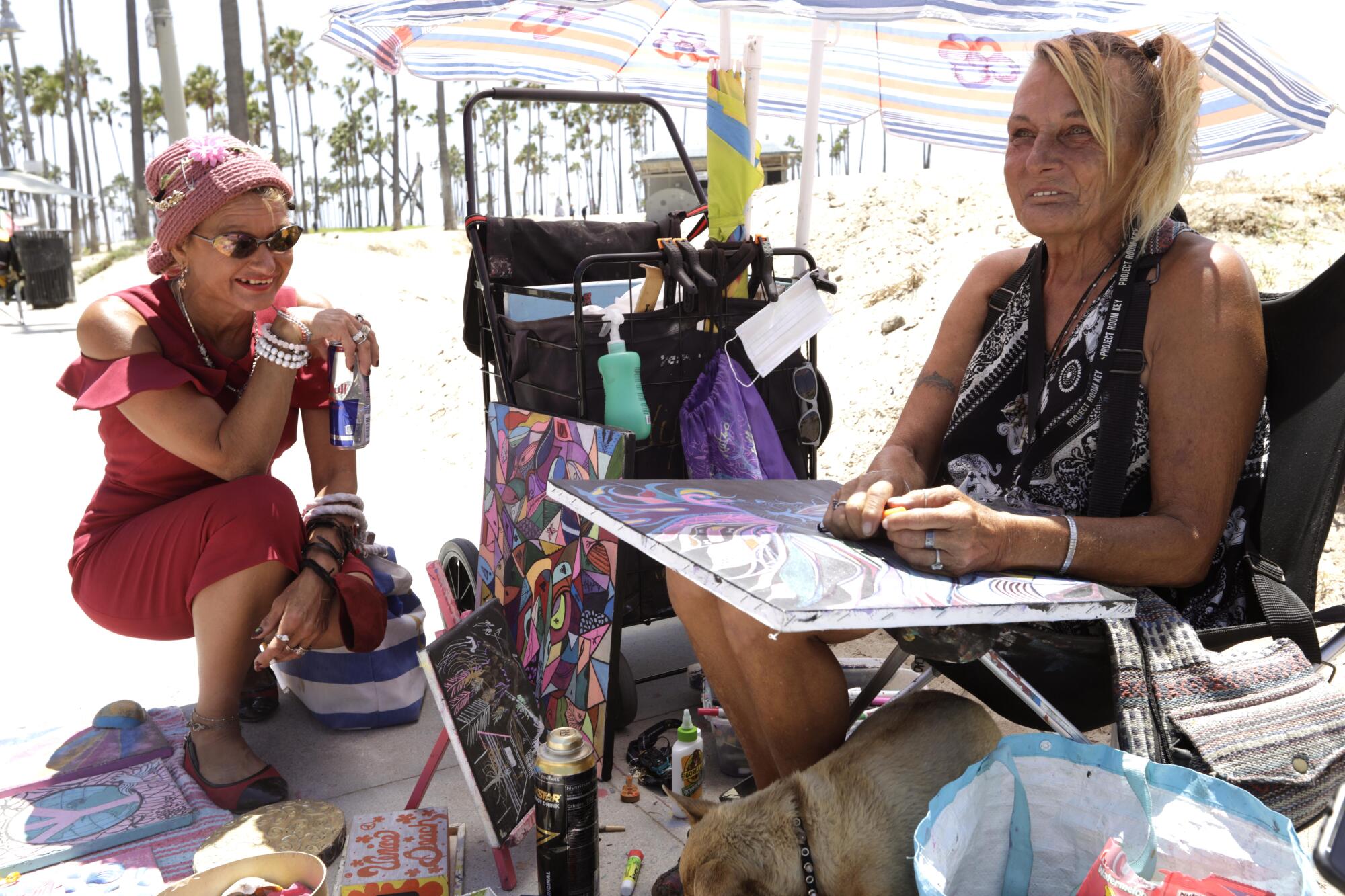
When they reached the hotel, Robles unpacked her cart so security workers could search it for prohibited items. Robles pulled everything out of their bag. They said they’ve been told the hotel will house them until the beginning of October.
It’s unclear what will happen after that. Moore hopes to have an apartment. Robles wants to find a way to stay by the water. Until then, though, she’s not going anywhere.
“If they want to move me to someplace else, they’re not moving me,” she said. “I’m not going anywhere else. I’m staying on the boardwalk.”
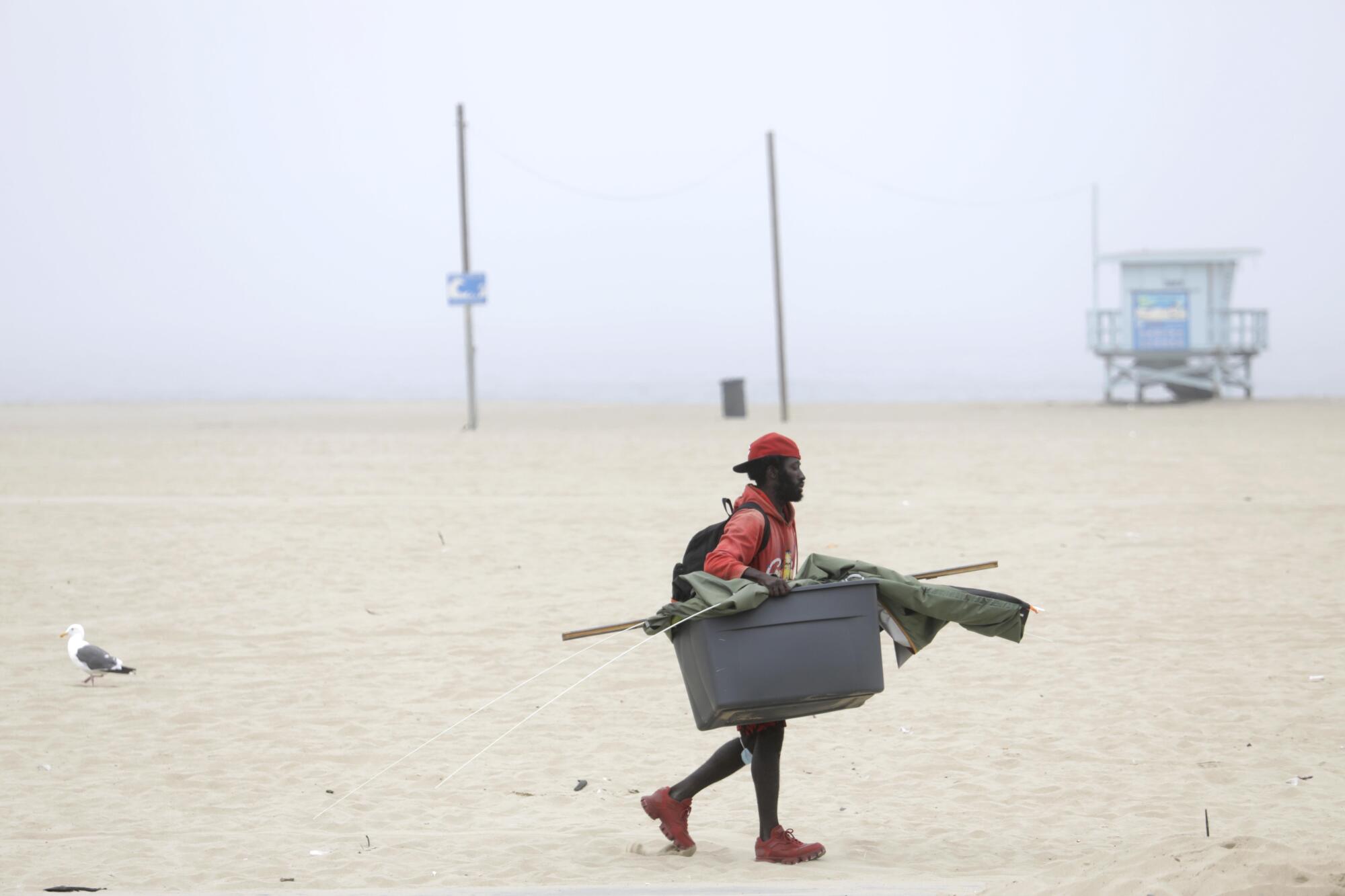
Times staff writer Doug Smith contributed to this report.
More to Read
Sign up for Essential California
The most important California stories and recommendations in your inbox every morning.
You may occasionally receive promotional content from the Los Angeles Times.
